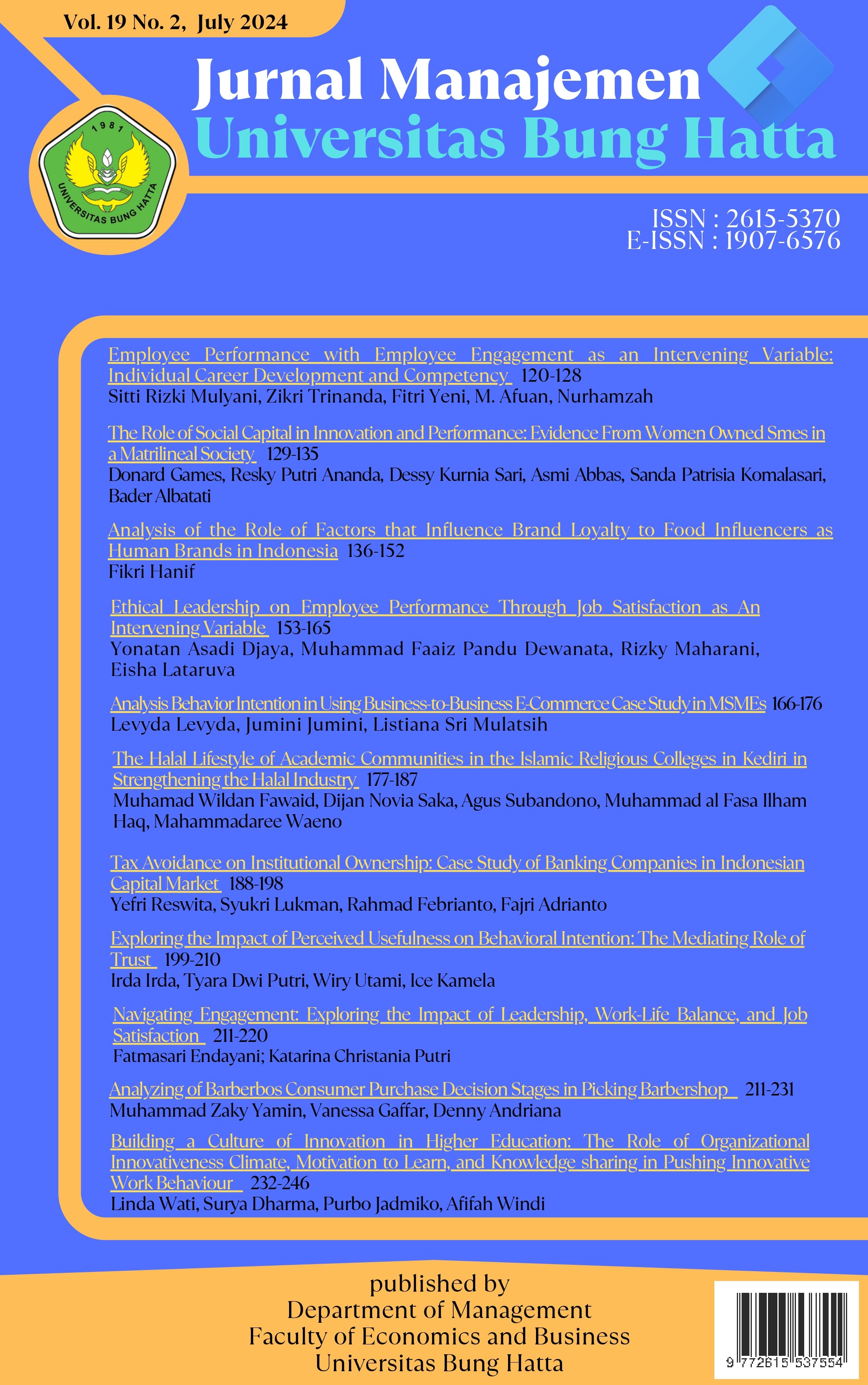The Role of Social Capital in Innovation and Performance: Evidence From Women Owned Smes in a Matrilineal Society
DOI:
https://doi.org/10.37301/jmubh.v19i2.24877Keywords:
Keywords: social capital; innovation; performance; women owned SMEs; matrilineal societyAbstract
Women-owned small and medium-sized enterprises (SMEs) may have difficulties in establishing networks and business partnership. This is in particular because they may have limitations in building social interaction, which in turn enhances their entrepreneurial activities and business performance. However, this may differ in matrilineal such as Minangkabau, where women have privileges, including in business activities. They are inherited ancestral properties such as land and houses that can be seen as valuable assets in starting and developing businesses. Therefore, it is interesting to know whether women-owned SMEs in Minangkabau can benefit from social capital, more specifically, bridging social capital. This type of social capital signifies social interaction with weak ties or new people from new places. This paper aims to examine the relationships between social capital, innovation, and performance in the context of women-owned SMEs in Minangkabau. We employed a quantitative approach using smartPLS 4.0. Data were analyzed from 100 women-owned SMEs in Padang, the capital of West Sumatra. It was found that bridging social capital is significantly and positively related to innovation and performance. Additionally, innovation mediated the relationship between bridging social capital and women-owned SME performance. Accordingly, promoting bridging social capital and innovation to women-owned SMEs is an effective way to enhance business performance. This may confirm that women-owned SMEs need to expand their social interaction with new people and from new places. In this case, they can benefit from digital technology facilitating this and increase their degree of innovation.
References
Bahauddin, A. (2023). The matriarch, the matrilineal system, and the Minangkabau Rumah Gadang. In: Jahn Kassim, S., Abdul Majid, N.H., Razak, D.A. (eds) Eco-Urbanism and the South East Asian City. Palgrave Macmillan, Singapore. https://doi.org/10.1007/978-981-19-1637-3_11.
Blackwood, E (2000). Webs of Power: Women, Kin, and Community in a Sumatran Village. Rowman & Littlefield Publishers.
Blackwood, E. (2008). Not your average housewife: Minangkabau women rice farmers in West Sumatra. In Ford and L. Parker (Eds). 17–40. Women and work in Indonesia. Oxon: Taylor & Francis.
Bradley, SW, JS McMullen, K Artz and EM Simiyu (2012). Capital is not enough: Innovation in developing economies. Journal of Management Studies, 49(4), 684-717. https://doi.org/10.1111/j.1467-6486.2012.01043.x.
Bulanova, O., Isaksen, E.J. and Kolvereid, L. (2016). Growth aspirations among women entrepreneurs in high growth firms. Baltic Journal of Management 11(2), 187-206. https://doi.org/10.1108/BJM-11-2014-0204
Curado, C and N Bontis (2006). The knowledge-based view of the firm and its theoretical precursor. International Journal of Learning and Intellectual Capital, 3(4), 367-381, doi: 10.1504/IJLIC.2006.011747.
Games, D, Agustina, T, Lupiyoadi, R. and Kartika, R. (2024). An examination of spiritual capital and innovation: Insights from high-growth aspiration entrepreneurs in a developing economy. Journal of Small Business and Enterprise Development, https://doi.org/10.1108/JSBED-12-2022-0504.
Games, D., Lupiyoadi, R., Agustina, T. S., Amsal, A. A., & Kartika, R. (2023). Social capital, learning from innovation failure, and innovation: Some insights from high-growth small businesses in a collectivist culture. International Journal of Innovation Management, 2350007. https://doi.org/10.1142/S136391962350007X.
Games, D., Soutar, G. and Sneddon, J. (2021). Personal values and SME innovation in a Muslim ethnic group in Indonesia. Journal of Entrepreneurship in Emerging Economies, 13(5), pp. 1012-1032. https://doi.org/10.1108/JEEE-01-2020-0008
Lyu, C, C Peng, H Yang, H Li and X Gu (2022). Social capital and innovation performance of digital firms: Serial mediation effect of cross-border knowledge search and absorptive capacity. Journal of Innovation & Knowledge, 7(2), 100187. https://doi.org/10.1016/j.jik.2022.100187.
Poon, JP, DT Thai and D Naybor (2012). Social capital and female entrepreneurship in rural regions: Evidence from Vietnam. Applied Geography, 35(1-2), 308-315. https://doi.org/10.1016/j.apgeog.2012.08.002.
Putnam, RD. (2000). Bowling Alone. New York. Simon and Schuster.
Rhaiem, K and N Amara (2021). Learning from innovation failures: a systematic review of the literature and research agenda. Review of Managerial Science, 15(2), 189-234. https://doi.org/10.1007/s11846-019-00339-2.
Shoham, A., & Lev, S. (2015). The Miles and Snow Strategic Typology and its Performance Implications. In Global Perspectives in Marketing for the 21st Century: Proceedings of the 1999 World Marketing Congress (pp. 214-220). Cham: Springer International Publishing. https://doi.org/10.1007/978-3-319-17356-6_67.
Williams, D. (2006). On and off the ’net: Scales for social capital in an online era, Journal of Computer-Mediated Communication, 11(2), 593–628. https://doi.org/10.1111/j.1083-6101.2006.00029.x.
Downloads
Published
Issue
Section
License
Copyright (c) 2024 Donard Games

This work is licensed under a Creative Commons Attribution-ShareAlike 4.0 International License.
Authors who publish with Jurnal Manajemen Universitas Bung Hatta agree to the following terms:
- Authors retain copyright and grant the journal right of first publication with the work simultaneously licensed under a Creative Creative Commons Attribution-ShareAlike 4.0 International License that allows others to share the work with an acknowledgement of the work's authorship and initial publication in Jurnal Manajemen Universitas Bung Hatta.
- The author holds the copyright of the submitted and published articles, with the understanding that articles are disseminated under the Creative Commons Attribution-ShareAlike 4.0 International License..
- The editor team is entitled to do the editing in accordance with the guidelines for writing or template in the Jurnal Manajemen Universitas Bung Hatta.
This work is licensed under a Creative Commons Attribution-ShareAlike 4.0 International License.












